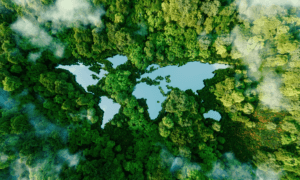Biodiversity is the variety of life on Earth, including species, ecosystems, and genetic diversity within species. It encompasses the diversity of plants, animals, and microorganisms, as well as the ecosystems they form and the variety of interactions between species.
The importance of biodiversity to ecosystems
Biodiversity is essential for our planet’s ability to function and provide resources that are important for human well-being. These resources range from food, fuel, and medicines to water purification and climate regulation.
The loss of biodiversity is a pressing global issue with significant impacts on the sustainability of our planet’s ecosystems. Human activities, including habitat destruction, over-exploitation, pollution, and climate change, pose significant threats to biodiversity. Consequently, many species face the risk of mass extinction. Additionally, ecosystems are being degraded because of these activities.
The business sector has a key responsibility to contribute towards preserving biodiversity. This article will explain how different human activities are harming our planet’s biodiversity and how companies can play a role in saving it.
Four threats to biodiversity
1. Habitat destruction
Habitat destruction is a significant driver of biodiversity loss, as it fragments and reduces the amount of land available for wildlife and disrupts the delicate balance of species interactions. This destruction occurs when natural habitats, such as forests, wetlands, and grasslands, are cleared or degraded for human purposes. Some common causes of habitat destruction include activities such as agriculture, urbanization, or resource extraction.
As habitats shrink or disappear, many species are left without food, water, shelter, and other resources they need to survive. This can lead to declines in population sizes and an increased risk of extinction. Habitat destruction also increases the likelihood of genetic isolation, inbreeding, and loss of genetic diversity as small and fragmented populations may struggle to exchange genes.
In addition, habitat destruction often leads to changes in the physical and biological conditions of the remaining habitat, such as increased erosion, altered hydrology, and the introduction of non-native species. These changes can significantly impact an ecosystem’s biodiversity, altering the structure and function of communities and their services.
Conserving and restoring habitats is essential for many species’ long-term survival and for maintaining healthy ecosystems. These can be done by reducing the rate of habitat destruction and protecting and restoring areas of high biodiversity value. Organizations can help by promoting sustainable practices to conserve habitats while supporting human livelihoods.
2. Over-Exploitation
Over-exploitation involves the excessive harvesting of species and the degradation of ecosystems. This can occur when species are hunted, fished, or collected at rates that exceed their ability to reproduce and maintain stable populations. Over-exploitation can also occur when forests are cleared for timber or wetlands are drained for agriculture.
The consequences of over-exploitation can be severe, as it can lead to declines in population sizes, increased risk of extinction, and alterations to the structure and function of ecosystems. It can also have cascading effects, as species declines disrupting the balance of species interactions, leading to further reductions and loss of biodiversity.
Over-exploitation example and impact
Overfishing decreases the abundance of certain species, which can alter the food web and reduce the overall biodiversity of an ecosystem. It was reported that Vaquita dolphins are down to a mere 10 individuals left in the ocean and threatened with extinction.
It is crucial to sustainably manage and conserve species and ecosystems to protect biodiversity and ecosystems’ resources. This involves setting limits on the harvest of species, protecting critical habitats, promoting sustainable practices, and reducing the drivers of over-exploitation, such as poverty and unsustainable consumer demand.
3. Pollution
Pollution has harmful impacts on individual species’ health and entire ecosystems. Damage can come from many sources, including chemical pollutants, such as pesticides and heavy metals, and physical pollutants, such as plastic waste and noise.
Chemical pollutants example and impact
Chemical pollutants can have toxic effects on individual organisms, leading to declines in population sizes and an increased risk of extinction. For example, pesticides can kill off predators, allowing pests to proliferate and reducing species diversity within an ecosystem. Heavy metals can accumulate in the tissues of organisms and cause reproductive failure, impaired immune function, and other health problems.
Physical pollutants example and impact
Physical pollutants can have severe consequences for biodiversity. Marine life, such as sea turtles and seabirds, can be harmed by ocean waste, while other species, including fish and corals, experience a decline in environmental quality. For example, non-biodegradable plastic can entangle and suffocate wildlife, causing injury or death.
Reducing pollution and promoting sustainable practices are critical for protecting biodiversity and maintaining healthy ecosystems. These involve reducing the release of pollutants, improving waste management practices, and promoting the use of alternatives to harmful chemicals.
4. Climate Change
As temperatures rise and weather patterns change, ecosystems are altered, disrupting the delicate balance of species interactions. Many species struggle to adapt to these changes and are at risk of extinction as their habitats shrink or shift.
Climate change example and impact
Rising temperatures are changing seasonal events, like the flowering of plants and the migration of animals, leading to mismatches between species that rely on each other for food or pollination. Warmer oceans are also causing coral reefs to bleach and die, which has cascading effects on the many species that depend on these ecosystems for food and shelter.
Climate change worsens problems like habitat destruction and over-exploitation. This is because it leads to frequent and severe droughts, hurricanes, and other natural disasters that can further reduce biodiversity.
Conserving biodiversity and mitigating the impacts of climate change is critical for our planet’s long-term health and its inhabitants’ well-being. This requires reducing greenhouse gas (GHG) emissions, protecting and restoring habitats, and promoting sustainable practices.
Business’s Role in Conserving Biodiversity
Businesses can play an essential role in conserving biodiversity through their direct impacts on the environment, and their influence on consumer behavior and public policies. Some of the ways businesses can support biodiversity include:
- Implementing sustainable practices: Look for ways your business can reduce the environmental impact of business operations, such as reducing waste and GHG emissions, or using renewable energy and conserving water.
- Supporting conservation initiatives: Invest in conservation projects and aid organizations working to protect biodiversity. This could include purchasing GHG offsets in this area or coordinating a hands-on volunteer day with employees.
- Promoting sustainable sourcing: Sourcing materials from suppliers who use sustainable practices is good for the environment, as well as reputational and supply chain risk mitigation. Look for certified forestry and sustainable fishing, and organizations featuring environmentally friendly products.
- Influencing public policies: Advocate for policies that support biodiversity conservation and sustainable development, such as policies for reducing GHG emissions or featuring sustainable land use practices.
- Engaging consumers: Help raise awareness about the importance of biodiversity conservation and the role of business in protecting the environment and promoting environmentally friendly products and services.
Preserving biodiversity represents a pressing challenge of great significance. By incorporating biodiversity conservation into business strategies, companies can contribute to preserving ecosystems and species while improving their reputation, reducing risks, and enhancing their long-term competitiveness.
Achieving effective biodiversity conservation requires collaboration and coordination among all stakeholders. This includes businesses, governments, communities, and individuals, ensuring that benefits are shared, and conservation goals are achievable. By taking a comprehensive and integrated approach to conserving biodiversity, we can protect and restore ecosystems, preserve species, and ensure our planet’s long-term health and well-being.
















